By Cleve C. Barkley
As 1943 drew to a close, Admiral Chester Nimitz’s Central Pacific campaign was gaining momentum. His forces had taken the Gilbert Islands that November and now targeted the Marshall Islands as the next step on the long road to Tokyo. Codenamed Operation Flintlock, the plan called for Rear Admiral Richmond Kelly Turner’s V Amphibious Force to bypass the Marshalls’ stronger outer defenses in favor of striking directly at Kwajalein Atoll in the archipelago’s center. Maj. Gen. Holland M. “Howlin’ Mad” Smith, USMC, commander of V Amphibious Corps, selected the Army’s veteran 7th Infantry Division to secure naval facilities at Kwajalein Island in the atoll’s southern group while Maj. Gen. Harry Schmidt’s untried 4th Marine Division, sailing directly from San Diego, would take Roi-Namur and its excellent airfield, 44 miles to the north.
Flat, barren Roi measures 1,200 by 1,250 yards, barely enough room to accommodate the airfield. Tethered to Roi by a 400-yard causeway and a narrow, lagoon-side sand spit lay Namur, encompassing 800 by 900 yards of heavily forested terrain that shaded the garrison’s barracks and other structures. Thirty-five aircraft and approximately 2,000 members of Japanese Vice Admiral Michiyuki Yamada’s 24th Air Flotilla occupied the islands, along with a 345-strong contingent of the 61st Guard Force and perhaps 1,200 service personnel. For defense, Roi-Namur boasted two batteries of twin-mounted 127mm guns, four 37mm cannons; 19 13.2mm heavy machine guns, and 10 20mm antiaircraft guns, nearly all facing northward in anticipation of an oceanside landing. Eight blockhouses and 52 pillboxes dotted the landscape with general purpose machine guns sprinkled throughout. Antitank ditches and fighting trenches girdled the beaches.
Following a two-month bombing campaign, Rear Admiral Richard Connoly’s Task Force 53 closed in on January 29, 1944, to commence a massive three-day bombardment, pummeling the defenders with more than 2,655 tons of high explosives. In November 1943, the Navy’s 21/2-hour preparatory barrage at Tarawa proved woefully inadequate, resulting in 3,178 Marine casualties. As a result, Admiral Connoly was committed to destroying every man, tree, and building that occupied Roi-Namur.
The first objectives were five outlying islands that were taken by the 25th Marines on D-day, January 31, with little trouble. With these secured, the howitzers of the 14th Marines were placed to support the main invasion scheduled for the following morning.
Preparing the Assault From the Lagoon
Throughout the night, U.S. Navy gunners hurled shell after shell at the hapless islands. Just before dawn on February 1, the cannonading ceased to allow the lumbering Marine-carrying LSTs (Land Ships, Tank) to break from the fleet and enter the lagoon. Once these were in place, the bombardment resumed with unbridled vigor.
In the lagoon, the Marines prepared for action. Colonel Louis Jones’ 23rd Marines were to take Roi with Lt. Col. Hewin Hammond’s First Battalion going in on Red Beach Two while Lt. Col. Edward Dillon’s Second Battalion stormed Red Beach Three, to Hammond’s right. Colonel Franklin Hart’s 24th Marines would make a simultaneous assault on Namur. Hart chose Lt. Col. Austin Brunelli’s Third Battalion to storm Green Beach One while Lt. Col. Francis Brink’s Second Battalion hit Green Two, to the right of the L-shaped Yokohama Pier, which served as the battalion boundary. W-hour, the time of assault, was set at 10 am.
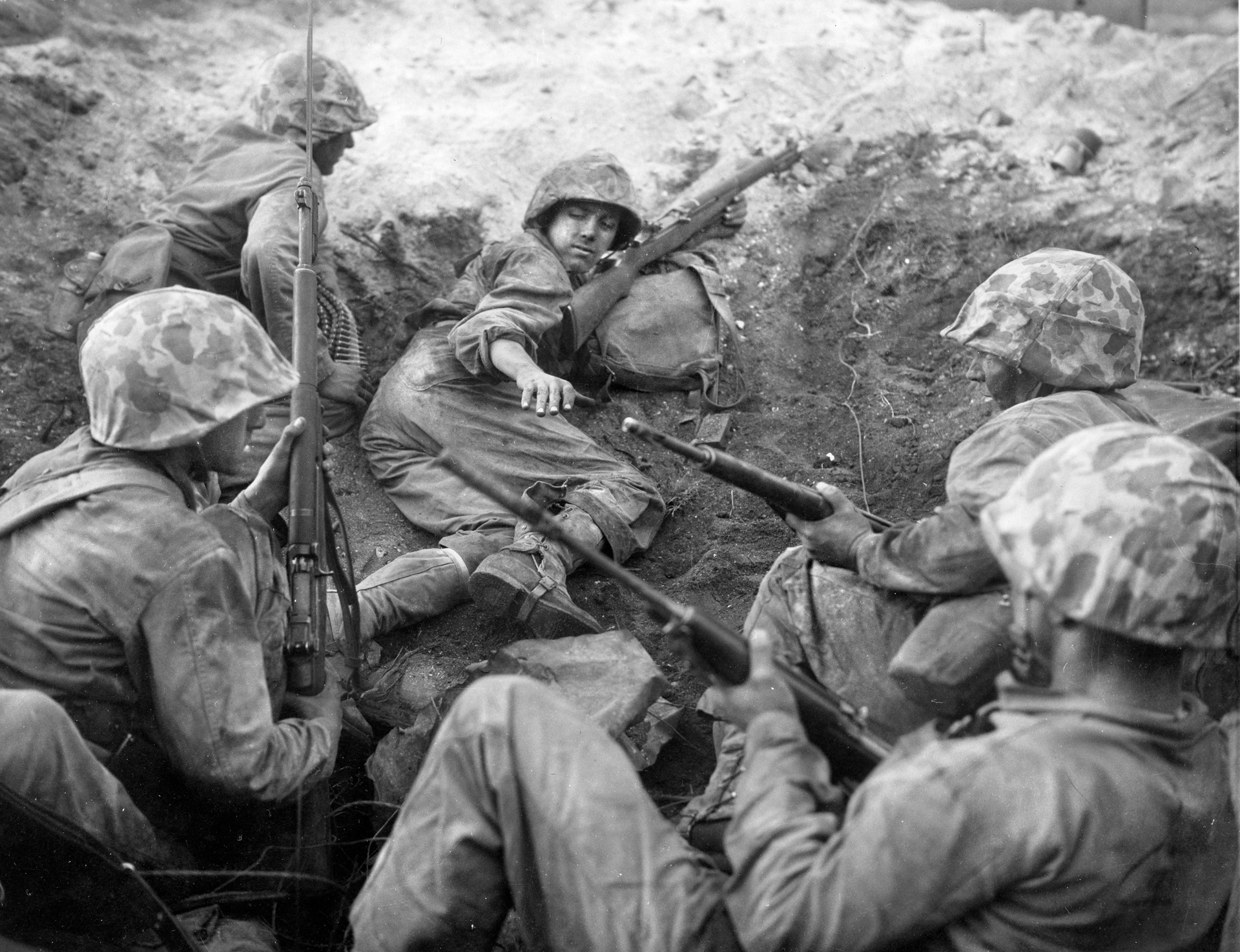
The infantry was divided into boat and assault teams with the former comprising riflemen and the latter a combination of demolitions specialists, bazooka men, and machine gunners, all embarked in LVT-2s (Landing Vehicle, Tracked). These amphibious tractors, or amtracs, were fitted with cleated treads designed to claw over barrier reefs. Each held 18 to 24 men. Four companies of armored LVT(A)s—amtanks—equipped with turreted 37mm cannons and machine guns would precede the infantry. Followup units would arrive in flat-bottomed LCVPs (Landing Craft Vehicle, Personnel).
The assault waves of the 23rd Marines would be carried by the 4th Amphibian Tractor Battalion, while those of the 24th would ride the amtracs of the 10th Battalion. However, the 10th was in a state of disarray, having seen continuous service the previous day ferrying elements of the 25th Marines to the outlaying islands. It had been a long and trying ordeal for the crews, which expended much of their fuel and virtually all of their energy while transporting personnel and supplies to and from the various islets. As darkness fell many were unable to locate their mother ships. Consequently, some LVTs ran out of gas, causing bilge pumps to cease working. A number swamped and sank in the choppy seas, while others sought refuge on nearby beaches. By morning only 62 of 110 LVTs allocated for the Namur landings were available.
As late as 6:30 am, Captain Charles Berkeley, Jr.’s Company G, one of the scheduled assault companies for Brink’s Landing Team Two, was unable to secure enough LVTs to make the landing, so a last minute revision called for Captain John Ross, Jr.’s Company E, initially battalion reserve, to exchange roles with G Company. Berkeley’s men would have to wait until enough vessels could be corralled to take them in. Similar shortages plagued Landing Team Three, but Lt. Col. Brunelli simply combined all available amtracs until both assault companies had sufficient transportation while his reserve element, Company L, remained aboard its LST with no means to embark. Chaos replaced order as the ad hoc assault waves struggled to gain the line of departure. As a result, W-hour was postponed until 11 am.
Meanwhile, the Navy kept a tight schedule. At 6:50 am Rear Admiral Howard Kingman’s Fire Support Unit One had eased to within 3,000 yards of Namur’s oceanside beaches to commence the final bombardment, while Rear Admiral Laurence DuBose’s Fire Support Team Two ripped off salvoes toward Roi. At the first inkling of daylight, the howitzers of the 14th Marines chimed in from the neighboring islets. By then the entire Japanese air fleet had been destroyed, as well as the communications and command structure, including Admiral Yamada and his staff, all of whom perished in the rubble.
While all this occurred, naval control officers tasked with aligning the waves of the 24th Marines were experiencing much consternation as unscheduled units hove into view while designated teams were nowhere in sight. Fifteen more minutes ticked by with negligible improvement. It was feared that once again unnecessary fuel consumption would jeopardize the LVTs circling impatiently in the lagoon. Furthermore, the initial landing teams still lacked proper reserves. Fortunately, the floating reserve, Lt. Col. Aquilla Dyess’ 1st Battalion, was already embarked in LCVPs 3,000 yards behind the line of departure.
Colonel Hart ordered Companies A and B to fill the void. But no sooner had these units arrived at the departure line than scraps of Company G materialized, loaded in a combination of LVTs and LCVPs, determined to reclaim their role as Landing Team 2’s reserve. Wave officers were at their wits’ end as Company A relinquished its position. Just then the red signal flag dropped from the control ship: “Launch the invasion.” It was 11:12 am. The landing craft of the 23rd Marines streaked for their designated beaches. Caught off guard, the coxswains transporting the disheveled 24th gunned their engines and set bearings for hostile shores, 4,000 yards away.
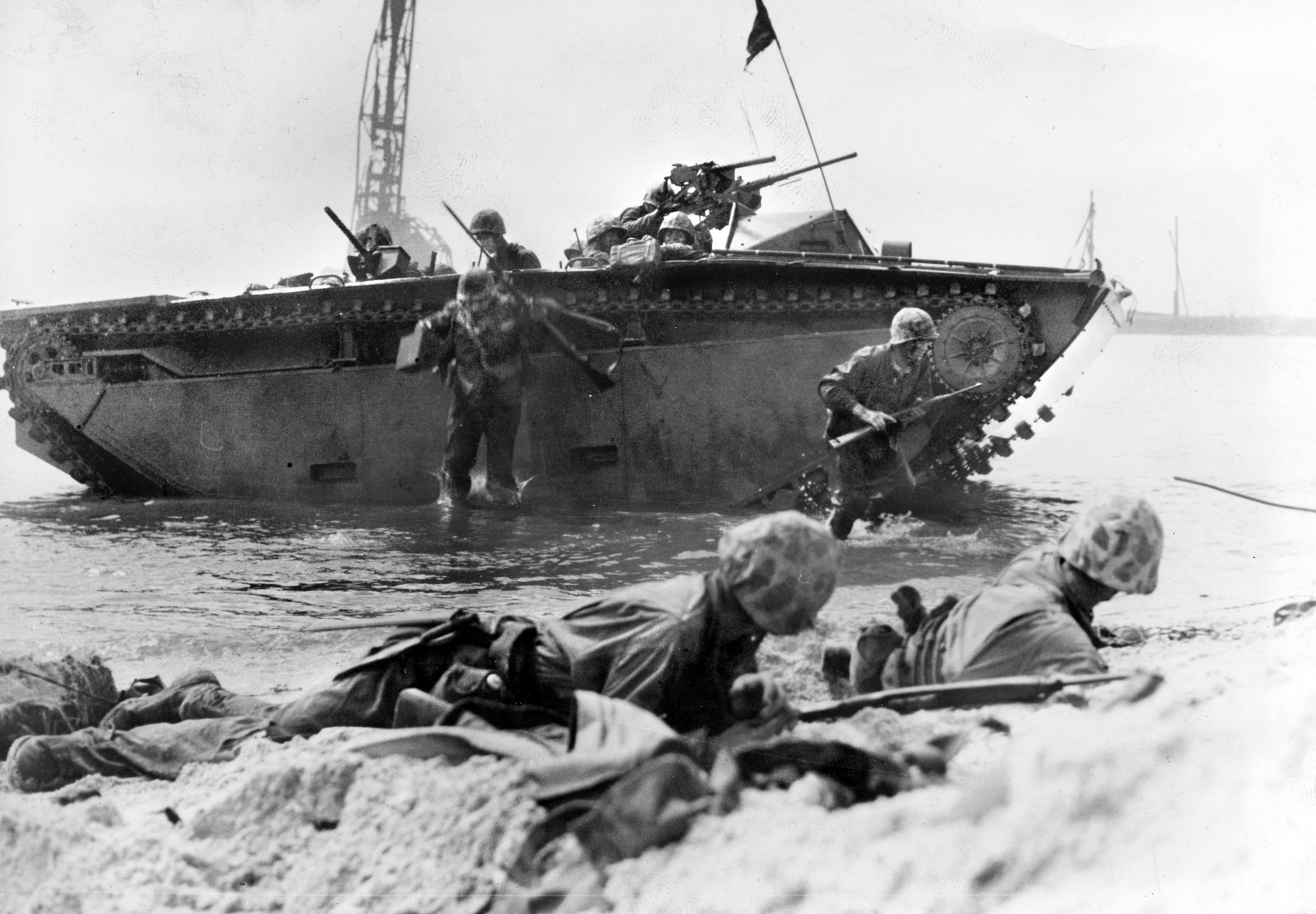
Landing on the Beaches
LCI(G) gunboats (Landing Craft, Infantry) led the procession, trailed by the armored LVT(A)s of the first wave with the assault infantry close behind. One thousand yards from shore, the gunboats swung broadside and cut loose with rockets and rapid-firing 40mm guns while the assault waves continued toward their destinations. On cue, the Navy’s bombardment shifted to the interior while dive bombers commenced their final runs.
At Roi, the 30 LVT(A)s assigned to the 23rd Marines came in hot, lacerating the thick battle haze with streams of searing tracers as they waddled ashore. They had hardly made landfall when an imposing antitank ditch loomed a mere 60 feet from the surf. Unable to proceed inland, the armored tractors lurched to a halt while releasing a galling fire from their machine guns and turreted cannons. It was 11:33 am.
Within 20 minutes the LVTs bearing the 23rd Marines clattered ashore. In the right-hand sector, the Marines of Companies E and F of Lt. Col. Dillon’s 2nd Battalion hit Red Beach Three and scrambled up a slight rise, then dropped to peer apprehensively into a wall of smoke and dust. Although plenty of gunfire flashed overhead, very little seemed to be incoming—naval artillery had destroyed virtually every beachside pillbox and the Japanese defenses lay in shambles. Dillon’s men crossed the ditch, shooting the few disoriented defenders encountered, then moved rapidly inland. By then the M4 Sherman medium tanks of Company C, 4th Tank Battalion had landed, followed by several light tanks of Company A. After crossing a collapsed section of antitank ditch, these quickly joined the assault. Within 20 minutes of landing, the Marines had reached the O-1 Phase Line along the lower arm of the airfield, about 200 yards inland. Company G beached soon after and commenced rooting out any bypassed enemies.
On the far left, Lt. Col. Hammond’s 1st Battalion landed on Red Beach Two five minutes behind Dillon’s men, also against negligible opposition. Captain James Scales’ Company A peeled left to assault a pair of large pillboxes reported to occupy Wendy Point, 300 yards distant. These Marines found only smoldering, rubble-filled craters where the fortresses purportedly stood—mute testimony to the Navy’s devastating firepower. Wendy Point, expected to be a tough battle, was a pushover.
An Improvised Armored Assault
Having secured their first objective without a fight, Scales’ men dashed up the western shore to claim their sector of the O-1 Line. En route, a spattering of gunfire erupted from a large blockhouse designated “Buster” 400 yards up the coast, but this too was quickly silenced after Marines crept close enough to pelt its entrance with grenades.
While Scales’ men were securing Wendy Point, Captain William Weinstein’s Company B pushed effortlessly inland to join Dillon’s men along the crater-pitted runway, where resistance proved feeble at best. Live Japanese were scarce. At times, Bangalore torpedoes or satchel charges were required to snuff out a few pernicious riflemen, who sniped from nearby trenches and debris-shrouded culverts, but by 1 pm all elements were on line and anxious to proceed.

By then Colonel Jones had landed and set up his regimental command post near the beach. Ecstatic at the ease of the operation, he radioed General Schmidt aboard the amphibious support ship USS Appalachian. “This is a pip,” he crowed, adding a few minutes later, “Give us the word and we’ll take the rest of the island.” General Schmidt advised Jones to calm down and prepare for the second phase of the attack.
Captain Robert Neiman, commander of Company C, 4th Tank Battalion, had no intention of settling down. His M4 mediums sat idle and exposed on the flat, open terrain, presenting juicy targets for the numerous antitank guns reported to infest the area. Favoring action over inaction, Neiman ordered his command to advance. The tanks set off, blasting every suspicious structure with their 75mm guns while bow gunners mowed down individual Japanese soldiers, who scurried like frightened rabbits before the massive treads. Upon seeing the tanks lumbering across the plain, the Marines of Company A moved out to provide protection while a platoon of amtanks waddled up the western coast in support. By 1:30 pm several M4s were dueling with enemy machine gunners defending the northeastern runway terminus called Nat Circle, while six others prowled the northern airstrip. It seemed as if victory was at hand.
However, General Schmidt was not pleased with this unauthorized action and ordered Jones to recall his wildcats lest they fall victim to the preliminary bombardment scheduled for the final push. It took nearly an hour before the mavericks were reined in and order was restored at the O-1 Line. Phase Two was to be launched at 3:15 pm with each assault battalion pushing straight up its respective half of the island.
Roi Secured
At 3:10 pm, the cruiser Santa Fe commenced pumping five-inch shells into troublesome Nat Circle. Twenty minutes later, the 2nd Battalion jumped off, supported by a 75mm half-track firing from mid-island. Although 20mm fire sputtered from Nat Circle, resistance was sporadic at best with Marines discovering many more dead than living Japanese. Within seven minutes Captain John Padley’s Company F was clearing out skeletal hangars along the northern runway while Captain Neiman’s tanks reengaged the enemy defending Nat Circle. Captain Carl Grussendorf’s Company E kept pace on Padley’s left. While advancing, four of Grussendorf’s Marines tumbled into a shell hole, believing that enemy soldiers occupied a nearby trench. Unwilling to take unnecessary chances, Pfc. Richard Anderson had just pulled the pin of a grenade when it slipped from his grip and rolled to the bottom of their crater. Realizing his blunder, Anderson threw himself on the bomb to save his comrades. He was awarded a posthumous Medal of Honor.
Initially, Hammond’s 1st Battalion remained stationary to provide supporting fire for Dillon’s men and did not join the advance until 4 pm. Led by a platoon of light tanks, Captain Fred Eberhardt’s fresh Company C bolted up the western seashore trailed by three 75mm halftrack guns. Mutilated Japanese corpses littered the landscape, residue of the fierce naval bombardment. The little resistance encountered came in the form of isolated rifle and machine-gun fire. In less than an hour Eberhardt’s men were mopping up Norbert Circle on the island’s northwestern corner.
Now only Nat Circle remained. Although Captain Neiman’s tanks had knocked out several enemy positions, one pillbox continued to spew machine-gun fire in three directions. Colonel Dillon ordered his reserve, Captain Frank Snepp’s Company G, to knock it out. While a half-track battered its steel door with 75mm rounds, a demolitions team closed in for the kill. When someone noticed a rent in the roof, a Bangalore-toting Marine climbed up and jammed his torpedo through the fissure while comrades ignited shaped charges at the apertures. Before the dust had settled, a half dozen Marines dashed inside and found three machine guns and three dead gunners. They also noted that the fort’s firing slits, like many of the island’s defenses, faced only north, east, and west, making their lagoon approach immeasurably easier. By 4:45 pm, all major resistance on Roi had ceased. Although the usual mopping up had yet to be completed, Colonel Jones declared the island secure at 6:02 pm.
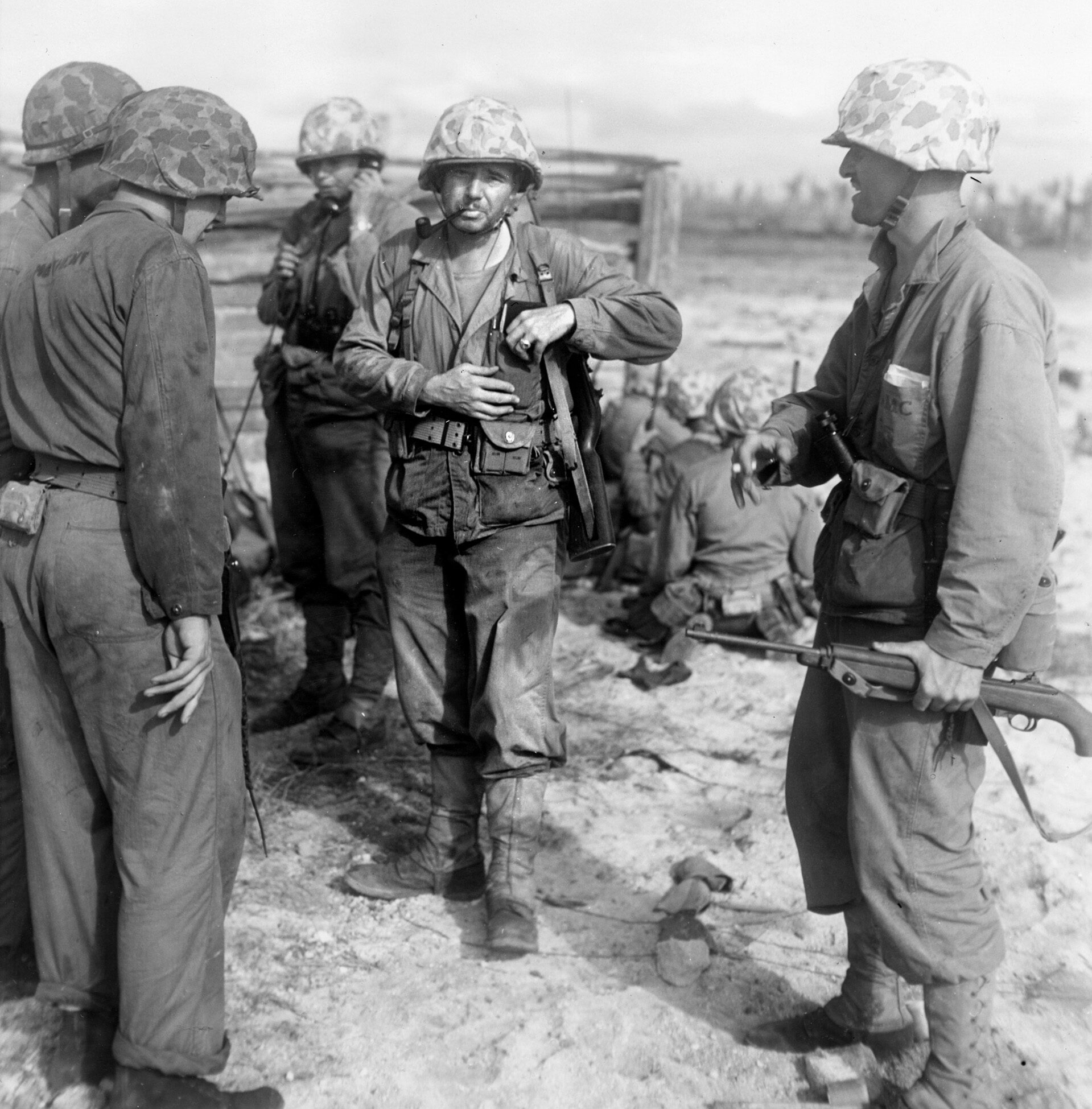
John Chapin on Green Beach One
For the most part, the battle for Roi had indeed been a pip. Namur would prove to be a different story.
A thousand yards from Namur’s beaches the jumbled assault waves of the 24th Marines churned past the rocket-spewing LCI(G)s as they skittered toward war’s seething cauldron. Nearly three dozen cannon-wielding amtanks of Companies B and D, 1st Armored Amphibian Battalion led the way, ordered to push 100 yards inland upon landing. For unknown reasons, the entire wave pulled up 50 yards short of the surf line where the landing craft continued to blast the unseen enemy.
Minutes later the infantry’s amtracs scuttled past the reluctant LVT(A)s. Chancing enemy fire, 2nd Lt. John Chapin of Company K peered over the bow of his vehicle and searched for his assigned landing site on Green Beach One. He saw nothing but roiling smoke and dust. Uncertain, he turned to consult with his platoon sergeant only to discover his right-hand man slumped over dead, his skull reduced to bloody pulp. Unnerved, Chapin refocused on the island before him.
Several hundred yards to Chapin’s right the amphibious tractors of Second Battalion clambered over Green Beach Two a bit before noon, while his own battalion struck Green One shortly after. All came in with machine guns blazing, intending to disgorge their Marines 100 yards inland, but as on Roi a deep antitank ditch forced them to an abrupt halt. Officers bellowed, “Let’s go!” and vaulted the gunwales. Covering fire rose to a crescendo as heavily-laden Marines plunged a full seven feet to the beach below and then scrambled forward a few yards to belly flop, breathless, before the impeding ditch.
On Green One intermittent machine-gun fire scattered several boat teams as Captain Albert Arsenault’s Company I and Captain Doyle Stout’s Company K disembarked. Lying in the sand, Chapin asked his platoon guide if he knew his men’s location. No sooner had the sergeant commenced pointing than his hand disintegrated in a spray of blood and bone. Wild eyed, the sergeant gripped his splintered stump and began yelling, “Sailor! Sailor!” employing the current term for corpsman, having been told that snipers understood the latter’s meaning and would invariably target any medic who hastened to his aid. Having lost two key subordinates within a matter of minutes, young Chapin pondered whether Namur was about to degenerate into another Tarawa.
Contact Lost With the Assault Battalions
On Green Two elements of both assault companies also became intertwined upon landing, but fortunately resistance in their sector was nearly nonexistent. Occasionally, a Japanese soldier would spring from a trench, snap off a round or two, then disappear. Marines answered with a shower of grenades followed by a headlong charge, which ended the gunman’s life. Only on the far right was serious opposition experienced when erratic machine-gun fire raked Company F from a pillbox planted above Sally Point on the extreme southeastern promontory. But this, too, was soon quelled with the cooperation of the heavy weapons of the 25th Marines firing from neighboring Ennugarret Island.
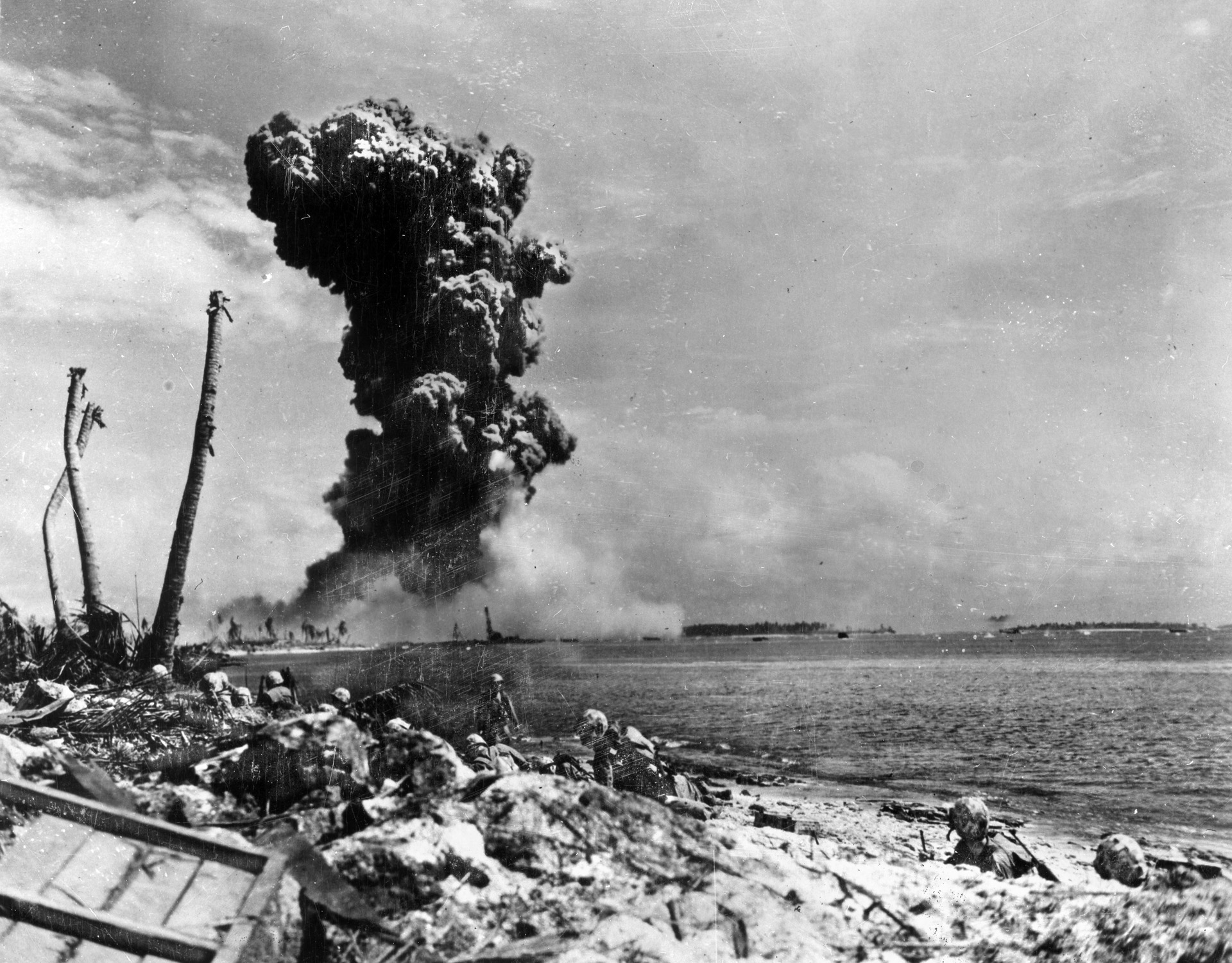
The boat and assault teams quickly cleared both beaches and pressed rapidly inland only to encounter an unexpected obstacle. Roi had been flat and open to accommodate the airfield, but Namur was heavily foliaged. Now, thanks to the savage naval bombardment, heaps of palm fronds, splintered trunks, and other debris meshed with the undergrowth to shroud the island’s buildings, bunkers, and pillboxes from view. As a result, the Marines advanced with measured caution. Sometimes a lone defender would stagger from concealment in a desperate bid to die for his emperor accompanied by one or two others, but all fell in a hail of bullets. Elsewhere, defiant pillboxes required the skills of demolitions men while lesser positions were left for followup troops. Within 15 minutes many teams had penetrated to a depth of 200 yards.
At this point, the left flank of Brink’s 2nd Battalion lost contact with Brunelli’s 3rd. This troubling situation developed after elements of Company E landed directly behind Company F on Green Beach Two. Upon entering the jumbled vegetation, both companies became tangled, with much of Company E somehow winding up on the battalion’s right flank—a complete reversal of the order of advance. As a result, a substantial gap appeared on the battalions’ boundary. Fortunately, about half of Captain Berkeley’s Company G had made landfall by then and was immediately dispatched to plug the gap. However, these troops ran into ever stiffening resistance from isolated enemy machine guns and riflemen and got no farther than 175 yards from the beach. Although they stumbled upon a lost team from Company E, the reserve was unable to gain contact with either assault battalion.
Lieutenant John Power’s Medal of Honor
Captain Berkeley’s men were not the only ones having a rough time. In the 3rd Battalion sector an assault team led by Chapin converged with that of Lieutenant John Power before a large, aggressively defended strongpoint constructed of sand-filled oil drums. Every attempt to bypass it was thwarted by scathing gunfire. Chapin and Power crouched behind a concrete wall 25 feet distant to formulate a plan. Under heavy covering fire, Power led a pair of automatic riflemen to the rear entrance while Chapin and another Marine armed with a Bangalore torpedo crept up to a narrow entrance near the front. Chapin flipped in a grenade, buying time for his companion to shove home the torpedo. Both rolled away just as the entrance collapsed in an effusion of smoke and dust. Mission accomplished, they quickly joined Lieutenant Power, who had somehow acquired a shaped charge. This time Power led the assault and the rear entrance vanished in a deafening roar as the bunker went silent. About then Chapin noticed blood oozing from Power’s belly, but Power simply shrugged it off and rejoined his platoon
A short time later Power faced another menacing pillbox. Intent on repeating his earlier feat, Power and a demolitions man darted forward and placed their charge against its door, then winced as the blast ripped open a jagged hole. Pressing one hand against his bleeding stomach, Power inserted his carbine into the jagged slot and emptied its magazine. As he paused to reload, shots sounded from within. Power reeled as another bullet punched his gut while a third ripped out his throat. Enraged, his Marines rushed forward and finished the job. Power was awarded a posthumous Medal of Honor.
Despite such desperate actions, enemy resistance remained scattered and uncoordinated. Captain Milton Cokin’s Company B hit Green Beach One at 12:45 pm and commenced mopping-up operations. Three light tanks of Company B, 4th Tank Battalion followed only to become immobilized by soft sand and shell holes. Just as the crews dismounted to free their vehicles nearly three dozen Japanese swarmed from supposedly vacant pillboxes and charged the tankers, who cut them down with small arms, netting two prisoners in the process at the cost of one Marine.
Meanwhile, Lt. Col. Brunelli’s battalion pushed steadily up the western half of Namur with one flank hugging the coast as his teams plunged steadily toward the O-1 Phase Line set at an east-west road codenamed Sycamore Boulevard, roughly two-thirds of the way inland. However, as with the rest of the island, this defining landmark was obscured by debris making it difficult for onsite commanders to determine its location.
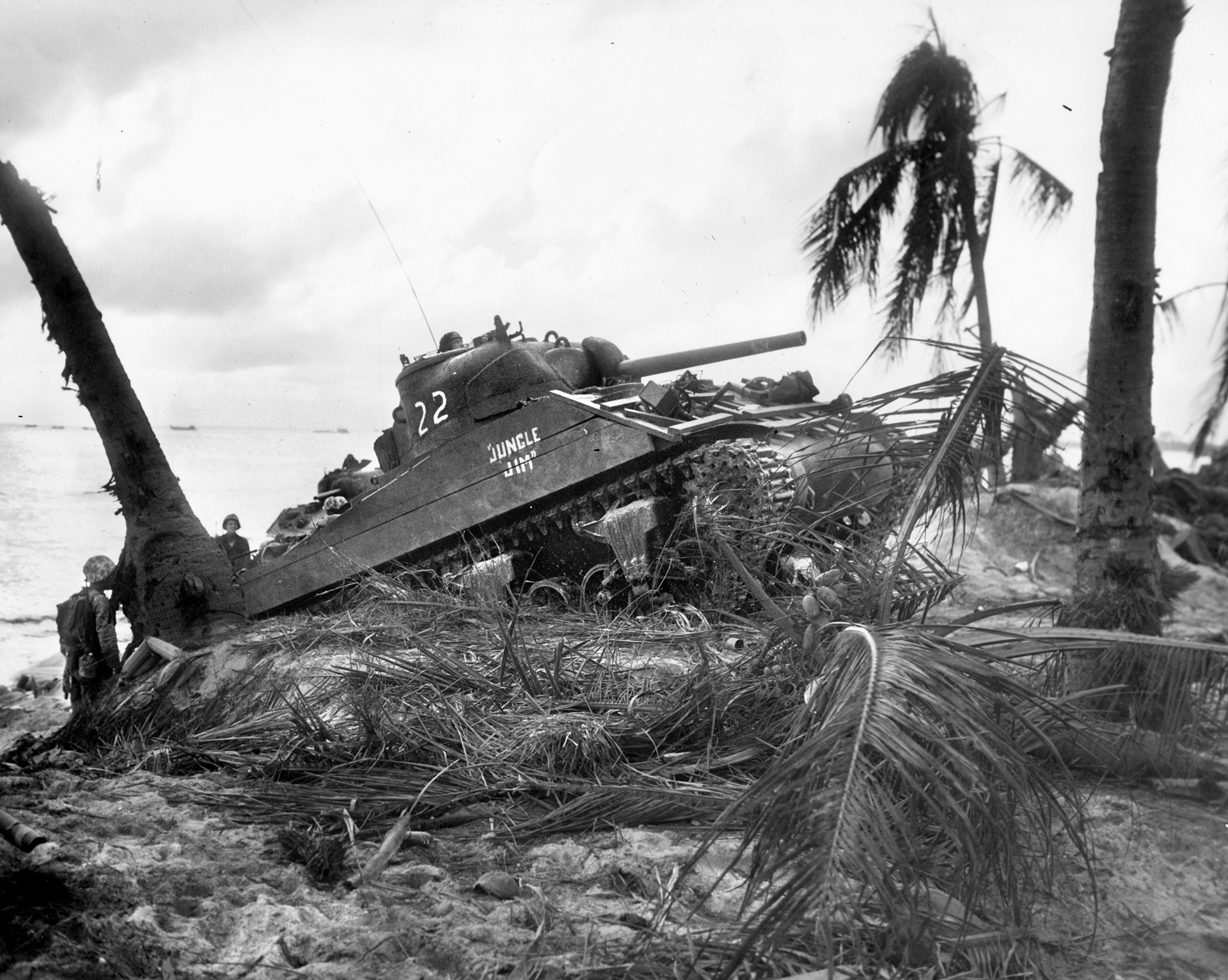
“The Whole Damned Island Has Blown Up!”
To the east, the right flank of Lt. Col. Brink’s disorganized 2nd Battalion was badgered by intense machine-gun fire coming from a sturdy blockhouse guarding Nut Lane near Nadine Point midway up the coast. Less than 200 yards to the left, other elements pulled up short of Sycamore when another large bunker loomed into view. There was no indication that it was occupied, but it was feared that any attempt to bypass it would result in heavy flanking fire or counterattacks from any defenders who might be waiting inside. Realizing it would be foolhardy to ignore it, demolitions men were summoned to ply their trade.
An assault team led by Lieutenant Saul Stein of Company F approached from the left while Lieutenant Joseph E. Lo Prete’s group from Company E closed in from the right. Demolitions men edged forward and placed a shaped charge against the bunker’s wall then quickly backed away. Upon detonation, 20 or more occupants bolted for the surrounding bush, no doubt convinced that they had just survived a potentially fatal blast. Once the dust settled it became obvious that the charge had done its job—a cavernous hole yawned from the building’s side. The sappers moved in again, this time with satchel charges that were flung into the gaping maw. What happened next was incomprehensible.
Everything within sight vanished in one catastrophic explosion. Smoke and fire and chunks of concrete shot skyward as if launched by a volcanic eruption, drawing up a dark gritty cloud that soared to a height of 1,000 feet or more. Those Marines not killed outright were rendered speechless, stunned by the sheer magnitude of the blast. Concussion waves bowled over men and trees and swept the lagoon with such force that incoming landing craft were stopped dead in the water. One Marine from Company F was blasted clear out to sea where he was later rescued, unbelievably intact, by the Navy. High overhead an aerial observer reported, “The whole damned island has blown up!”
At the moment of detonation every Marine’s face on neighboring Roi snapped “Eyes Right!” with parade ground precision. Many believed that the entirety of Namur had been destroyed and every Marine there killed. Others thought that either the Navy had resumed its shelling or that a 500- or 1,000-pound bomb had been inadvertently dropped. Later evidence proved that the bunker had been utilized as a munitions storage facility that housed 100 or more torpedo warheads that were detonated by the demolition team’s satchel charges.
A heavy brown cloud billowed from the epicenter and seeped across Namur like something inherently evil. Suddenly no one could see. Marines gagged and choked as acrid fumes clogged their lungs. Fearing that the Japanese had launched a chemical attack, a few cried, “Gas! Gas!” as they searched frantically for protective masks discarded earlier as useless equipment.
But the nightmare had only begun. Suddenly, monolithic chunks of reinforced concrete came screaming to earth like killer asteroids, accompanied by smaller but no less deadly missiles of concrete, splintered tree trunks, and lumber, some of which splashed far out to sea. At least one Marine was crushed by the unholy avalanche, and others were injured. In addition, scores of the stowed torpedo warheads tumbled from the darkness, some of which exploded upon impact.
In rapid succession, two more shattering detonations wracked the front, possibly from other bunkers. For a time, chaos reigned. In all, 20 Marines were killed and some 100 wounded. The effect on Captain Garretson’s Company F was devastating: 14 killed including Lieutenant Stein and 43 wounded. Lt. Col. Brink was also injured but refused evacuation and quickly called up his recently landed reserve, Company A, to bolster his devastated command.
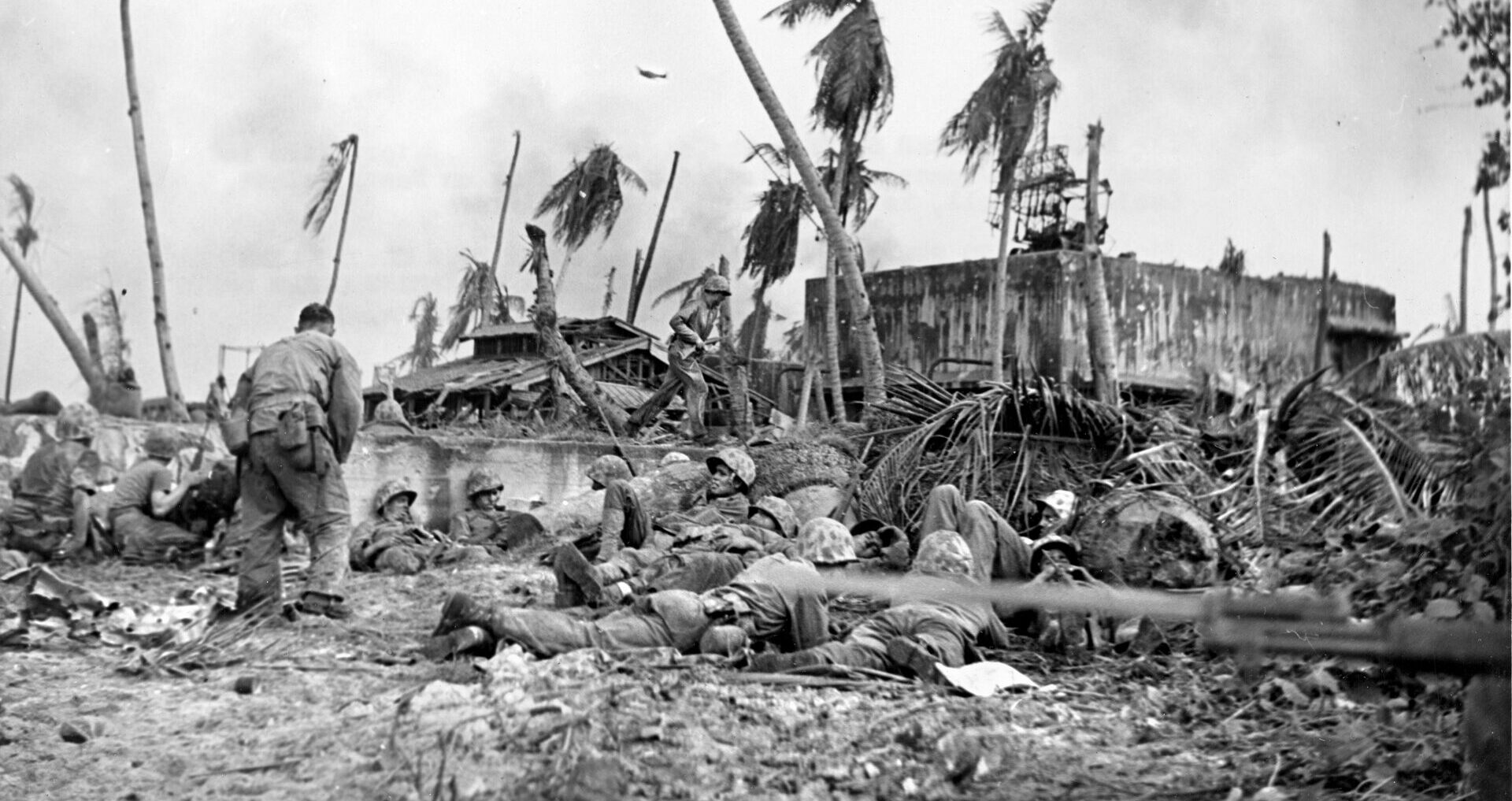
The Defenders’ Stiffened Resolve
While these morale-sapping events disrupted the regiment’s momentum, they seemed to have encouraged the Japanese. Suddenly, the entire front came alive with the distinctive chatter of Nambu machine guns and the crack of Arisaka rifles. From that moment the battle took a dramatic turn for the worse. What had once been a steady drive against fragmented and poorly organized defenders now disintegrated into an inch-by-inch progression as the scattered teams closed on the O-1 Line. By 2 pm most had gained Sycamore Boulevard, but every attempt to cross was checked by intense machine-gun fire from three well-placed blockhouses fronting the Second Battalion sector: one at Nubbin Lane in the island’s center, another located at the end of Nut Lane, not far from Nadine Point on the east coast, and a third at a nearby intersection designated Road Junction 58. The tempo slowed and then ground to a halt.
By that time, the regimental command post was ashore and fully operational. Realizing that the enemy had shaken off the stunning effects of the naval bombardment, Colonel Hart ordered a general halt to reorganize and reinforce his front with orders to resume offensive operations at 4:30 pm.
With the 2nd Battalion still reeling from the bunker catastrophe, Captain Irvin Schechter’s Company A assumed operations on the far right flank while Captain Horace Parks’ freshly arrived Company C moved up to relieve the shaken Company E. At the same time, Captain Houston Stiff’s Company L, which had finally found enough boats to make the landing, moved up to 3rd Battalion to relieve Company B from its mopping-up duties, enabling that unit to replace battle-weary Company K, which in turn was sent to Pauline Point, the finger-like sandbar jutting between Roi and Namur, to provide flanking fire for the upcoming attack alongside the regiment’s heavier weapons.
Now reorganized, the front ran from left to right as follows: Company I anchored the western shore abutting Company B near the junction of Sycamore Boulevard and Nasturtiam Lane while Company L hunkered as Third Battalion reserve. In the center, half of Second Battalion’s Company G carried the line eastward along Sycamore Boulevard with Companies F, C, and A extending the front toward Nadine Point; remnants of Company E remained on line, having failed to learn of their relief.
As the hour of attack drew nearer, several light tanks and LVT(A)s rumbled up and commenced pumping 37mm shells into the three troublesome blockhouses that had plagued the infantry along Sycamore Boulevard. While those at Nubbin Lane and the road junction were neutralized, the guns proved too feeble to penetrate the thick concrete of the Nut Lane box, which remained a thorn in the battalion’s side for the balance of the day.
At precisely 4:30 pm, Brunelli’s Third Battalion launched its attack but was stunned by the ferocity of the Japanese response. Pockets of resistance more than made up for their lack of coordination with a tenacity born of desperation, pecking away with machine guns and sniper fire as Marines dashed forward amid bursting mortar shells. The dense terrain continued to mask enemy strongpoints, and the advance on the left was justifiably slow. At one point, Corporal Alex Haluchak’s squad of Company B was pinned down by heavy machine-gun fire. Haluchak, already twice wounded, told his men to sit tight while he scouted the gun’s location. Now alone in enemy territory, he stormed the menacing weapon and killed its crew, enabling his squad to proceed. Haluchak received the Navy Cross.
On the right the confusion of reorganization delayed the 2nd Battalion’s attack for another hour. Supported by the light tanks of Company B, 4th Tank Battalion, the infantry crossed Sycamore Boulevard and waded into a jungle crackling with small-arms fire. Being forced to investigate every damaged building and pile of debris, the infantry soon lost contact with the tanks. The armor pressed on, covering one another with machine-gun and canister fire as they negotiated the jungle-like terrain. Within 20 minutes it had gained Narcissus Street, 300 yards beyond the line of departure. Here, several tanks pivoted right and churned down the road as it cut southeast toward a junction with Sycamore Boulevard.
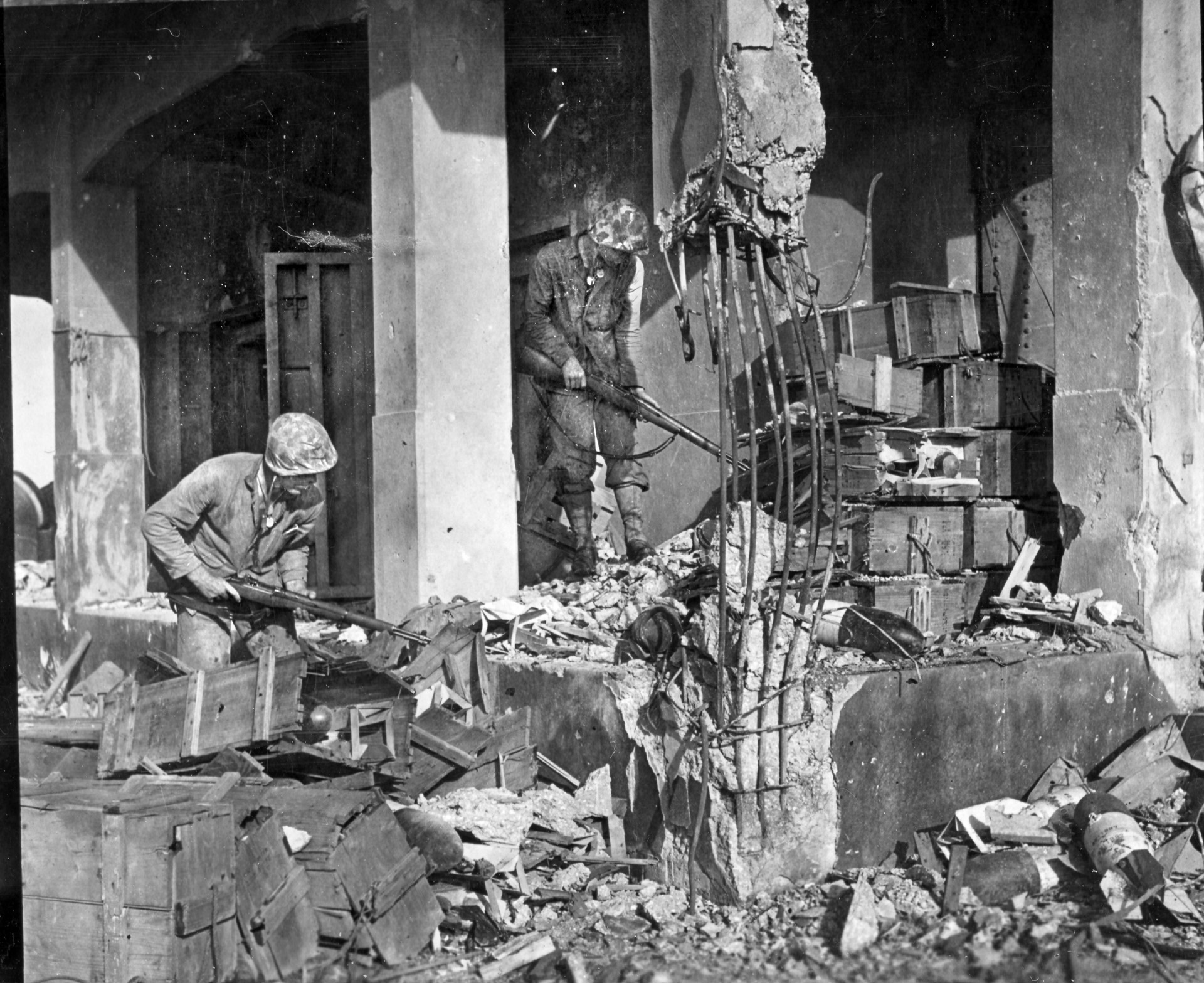
After dodging one obstacle, Captain James Denig’s command tank became isolated from the others, so Denig stopped in a clearing to gain his bearings. At that moment, five Japanese charged from the underbrush and swarmed his vehicle. One mounted the turret and dropped a grenade through a small signal port left open for ventilation, wounding the entire crew while setting the compartment on fire. Just then Pfc. Howard Smith of Company A broke through the brush and sprayed the tank with his BAR, killing four assailants while a buddy picked off the fifth. Climbing aboard the smoldering wreck, Smith pulled the mortally wounded Denig from the hatch then returned to extract two others but failed to rescue the driver who perished in the flames. Smith’s actions earned him a Navy Cross.
Meanwhile, Captain Garretson’s decimated Company F finally broke through in the center and also reached Narcissus Lane, only 35 yards from the northern beach. Lacking proper support, Garretson was ordered back 100 yards where his men maintained a bulging salient.
The Nut Lane Blockhouse
Things were perhaps even more desperate on the far right where elements of Company A pushed up the eastern coast near Nadine Point. At the tip of the spear was an irascible, tobacco-chewing former Marine Raider, Corporal Arthur Ervin, who charged far ahead of the lead scouts, flinging grenades and triggering round after round at every Japanese soldier he saw. When the company came upon the formidable blockhouse at Nut Lane, it was Ervin who led the assault. First Lieutenant Roy Wood’s platoon was hot on Ervin’s tail when heavy gunfire drove them to ground.
Dodging bullets, Lieutenant Phil Wood (no relation to Roy) and machine gunners George Smith and 18-year-old Steve Hopkins, son of presidential adviser Harry Hopkins, tumbled into a trench where they set up their Browning. Smith quickly went to work, adding havoc to mayhem while Wood summoned Hopkins to follow him farther down the trench. En route they passed a Japanese “corpse” that suddenly sprang to life and pulled a grenade. Hopkins was startled, and his rifle was nearly touching the soldier’s skull when he pulled his trigger. The Japanese soldier simply shook his head, as if stunned. Shocked, Hopkins quickly emptied an entire clip into the superman. “Did you see, Mr. Wood?” Hopkins queried incredulously. “Did you see the grenade? Did you see what he was about to do?”
Just then Japanese mortar rounds began plunking near the trench. Undaunted, the impetuous Ervin vaulted the parapet to conduct a one-man reconnaissance of the imposing Nut Lane blockhouse, killing two machine gunners as he did so while enemy bullets ripped the helmet from his head. Upon his return, Ervin gave his report. Lieutenant Phil Wood decided his platoon’s 60mm mortars were the answer, but before the weapons could be deployed bazooka rounds slammed into the bunker and Marines rushed forward. First to arrive were Ervin and Lieutenant Harry Reynolds, the company executive officer. Both whipped grenades through the embrasures until gunfire from a nearby dugout punctured Ervin’s abdomen, evoking a litany of curses. Lieutenants Reynolds, Wood, and Wood grabbed a few men and rushed the offending position, bombarding it with grenades and rifle fire as Sergeant Frank Tucker and Corporal Franklin Robbins sprang up and charged. Tucker shot an enemy rifleman guarding the dugout’s entrance, then both ducked inside and riddled the interior with bullets, killing every enemy soldier.
Meanwhile, the Nut Lane bunker resumed firing. Hoping to outflank it, a dozen Marines crossed Sycamore Boulevard only to come under fire from a maze of entrenchments near the beach. Before others could join them, heavy machine-gun fire swept the road, denying further penetration. Led by Lieutenants Roy Wood and Reynolds, the isolated squad took matters into its own hands. Platoon Sergeant James Adams, a tagalong from battalion headquarters, charged the trench and gunned down a machine-gun crew only to crumple dead in a hail of bullets. Close by, Corporal Robbins emptied several clips, singlehandedly stopping an enemy counterattack before falling himself. Reynolds dropped several Japanese soldiers from behind a fallen log until a bullet slashed his leg.
Down the line, Sergeant Tucker stood upright behind a shattered tree trunk and zeroed in on dozens of enemy soldiers who scurried in the trenches a mere 15 yards away. Return fire ripped bark from Tucker’s meager shelter. One round pierced his helmet and another drained his canteen, but Tucker kept firing. Noting Tucker’s advantageous position, other Marines began tossing him grenades which the sergeant hurled into the trench until all were exhausted. More bullets whacked Tucker’s tree. Sensing disaster, the sergeant called for covering fire. Pfcs. Lawrence Knight and Lester Kincaid hammered away with their BARs. Just as Tucker scuttled away, a bullet splattered Knight’s cheek. Angered, Knight resighted his weapon and resumed firing until Reynolds ordered him to seek aid.
Their blood up, the other Marines closed in and drove the defenders from their works, killing a least 30 as they scampered for the shelter of another pillbox. By then dusk had arrived and the surviving Marines dug in, still separated from their comrades.
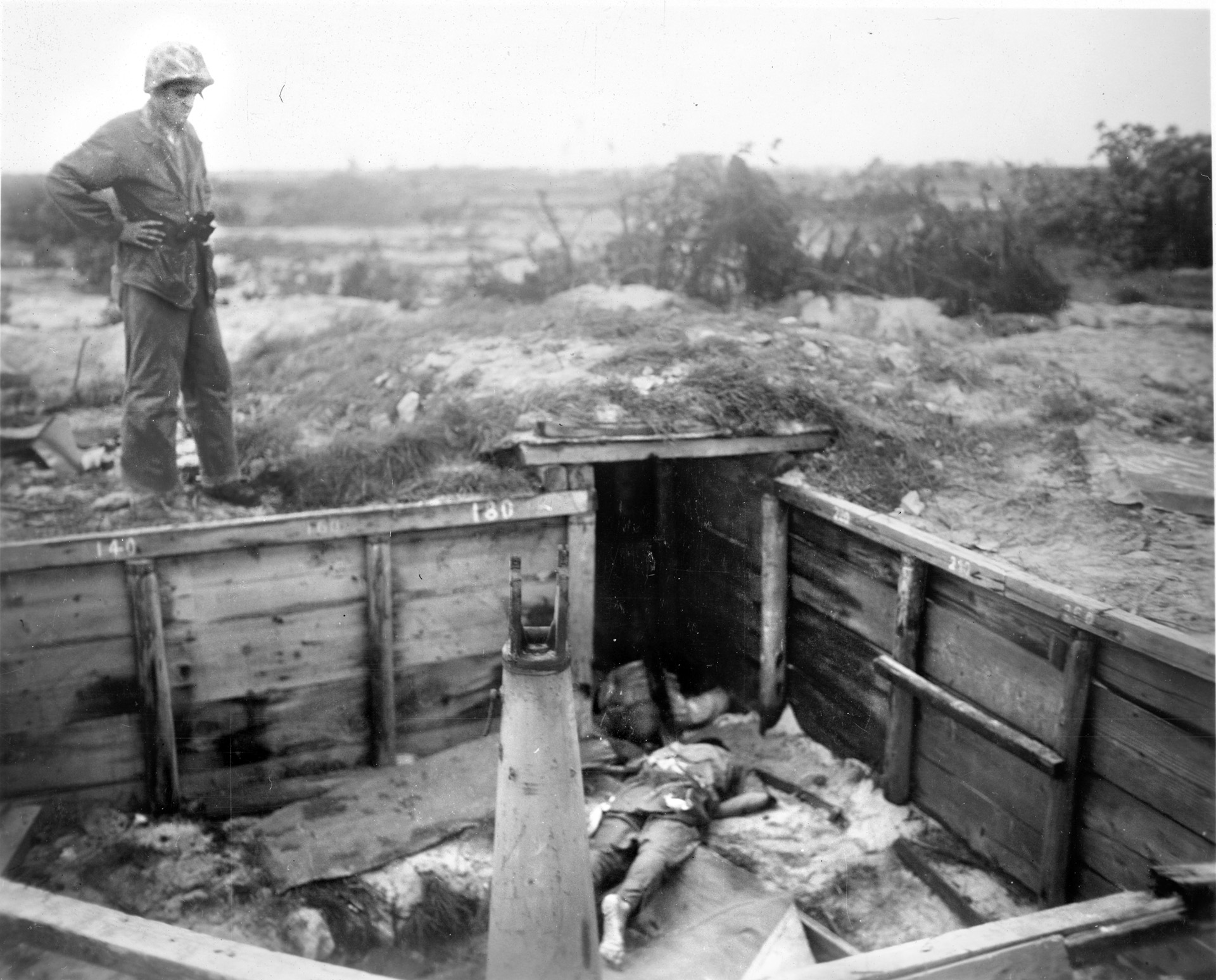
“Banzai! Banzai!”
As daylight waned, Colonel Hart opted to cease offensive operations in favor of digging in with expectations of securing the island the following morning. Knowing that the northern beaches were but 200 yards away, the few combat veterans thought this folly. Having experienced the terror of Japanese infiltration tactics and the obligatory Banzai attack, these old hands believed the regiment should have pressed on and finished the job. But being Marines, they obediently pulled their entrenching tools and began hacking at the soil.
Darkness fell. Star shells popped and shimmered throughout the night, illuminating a landscape rife with rotting corpses, shredded foliage, and the battered ruins of the enemy’s structures. No one slept. At times the highpitched crack of Arisaka rifles sounded from the rear as well as the front and flanks, bearing evidence that the enemy was indeed all around. American arms responded, stitching the darkness with neon tracers. At times resolute infiltrators died at the rims of hastily dug foxholes. Marines died too, including young “Hoppy” Hopkins, who had earlier saved his lieutenant’s life. Hopkins was mortally wounded while pulling flank security near Nadine Point.
Just before daybreak a rustling in the brush fronting the 3rd Battalion caused eyes to strain and heartbeats to quicken. Trigger fingers tensed as the thrashing swelled to a universal clamor, and then it happened. “Banzai! Banzai!” Japanese soldiers burst from the undergrowth in groups of 10 to 20, yelling madly and brandishing rifles, bayonets, and swords. The Marines let loose with everything they had. A gap between Companies I and B was exploited, and the fight degenerated into a tangle of bayonets, knives, and clubbed rifles. Only the timely arrival of Company L and a few medium tanks stabilized the situation. Now reinforced, the Marines counterattacked.
During the melee, six Marines had taken position in a shell hole when something thudded and rolled sputtering to their feet. Private Richard Sorenson hesitated and then threw himself on the grenade just as it exploded. In a nearby crater, Corpsman James Kirby was treating several patients after they had been overrun earlier that night and heard Sorenson’s screams. Scrambling to his assistance, Kirby dragged Sorenson to his impromptu aid station, now overflowing with 15 wounded Marines. Although grievously wounded, Sorenson survived to receive the Medal of Honor for saving his buddies’ lives.
The entire action was over within 35 minutes. Company B’s Third Platoon had nearly been wiped out, but more than 100 enemy corpses were strewn before its position. As a precaution against similar attacks, Lt. Col. Brunelli ordered Company K to rejoin his command from Pauline Point.
The Last Marine Attack
General Schmidt, the divisional commander, had landed the previous evening and took command of the entire operation. Wanting to reinforce his line, he ordered Captain Neiman’s Company C, 4th Tank Battalion and a battalion of the 23rd to cross from Roi to Namur. At that time only four tanks had sufficient fuel and ammunition to make the trip. These had assisted 3rd Battalion in repelling the early morning Banzai attack. But now, with supplies stockpiling on both beaches, the balance of Neiman’s command was fueled, armed, and moving into position. The men of the 23rd were held as reserve.
The attack would resume at 9 am. Company K, now reunited with Landing Team Three, would roll up the western shore with Companies I and L deployed to its right and supported by two platoons of Captain Neiman’s medium tanks. Captain Cokin’s decimated Company B was pulled back as battalion reserve.
Lieutenant Colonel Aquilla Dyess of 1st Battalion assumed command of the right flank after Francis Brink had been evacuated for wounds received during the bunker explosion. Dyess kept Company G, now intact, tied in with Brunelli’s battalion while Companies F, C, and A extended his line to the eastern shore. Captain Ross’s Company E remained in battalion reserve while Company B, 4th Tank Battalion would provide support.
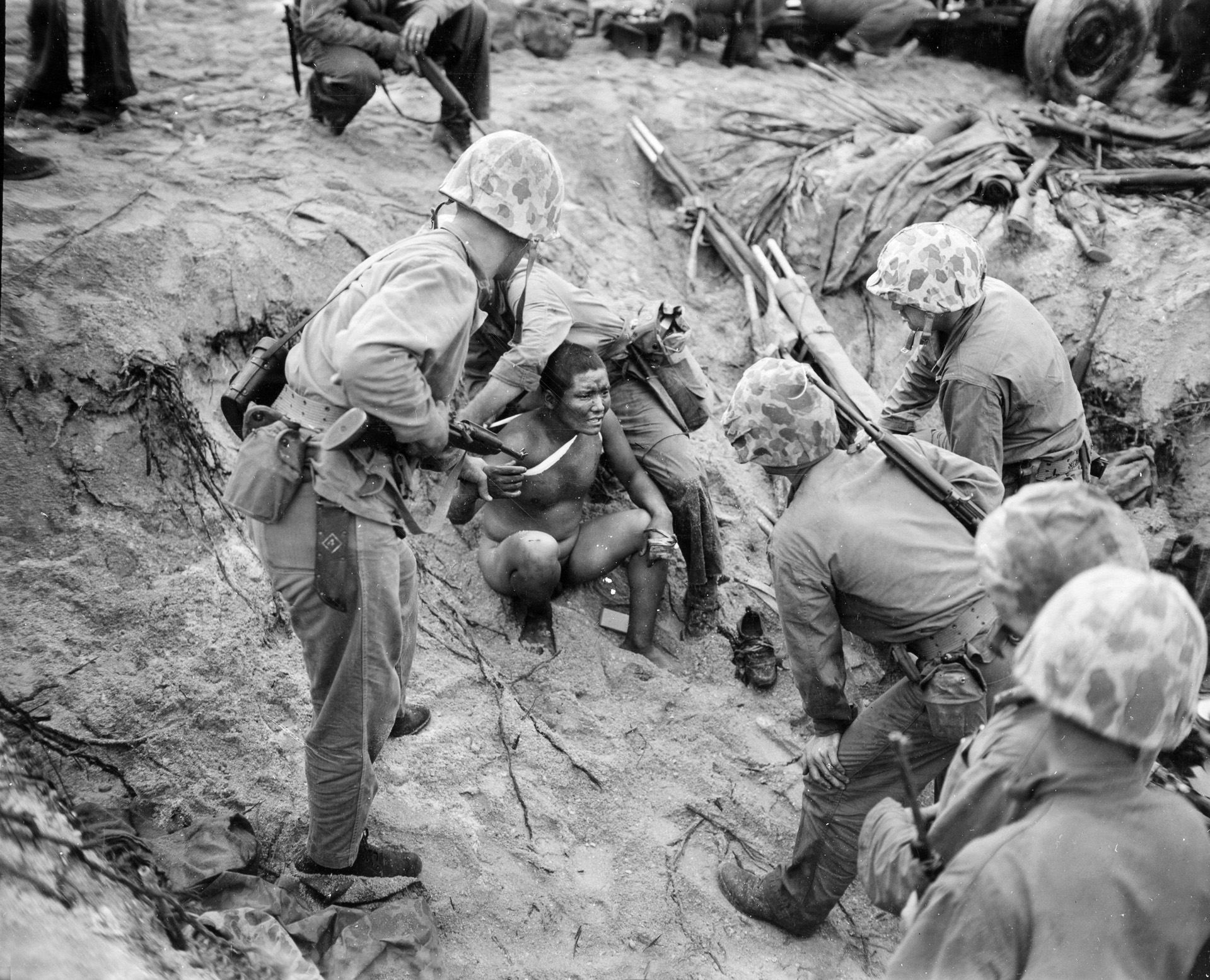
The attack jumped off on schedule with Brunelli’s men easily overrunning the few enemy troops that remained. Within two hours his battalion had reached Nora Point on the island’s northwest corner where it wheeled right to sweep the oceanside beaches.
Colonel Dyess did not get started until 10:05 am due to the late arrival of his armor. The stubborn Nut Lane blockhouse continued to defy every attempt against it until tanks and half-tracks beat it into submission. After that the pace accelerated. Dyess seemed to be everywhere at once, cajoling reluctant Marines here and leading others there as they combed the underbrush of battle-weary Japanese. By mid-day his Marines were within sight of the northern beaches where 25 to 30 Japanese had rallied in a deep antitank ditch. A platoon of light tanks trundled up and scoured the trough with machine-gun and canister fire. That done, Dyess sprinted to the ditch’s rim to direct one final assault, and a burst of machine gunfire ripped through his body. For his dynamic leadership and unflinching courage, Dyess was awarded a posthumous Medal of Honor, the fourth and final such award for the two-day battle.
Four Medals of Honor in the Battle For Roi-Namur
Shortly after noon, both battalions converged near Natalie Point, the island’s northernmost promontory, where the Marines ferreted out the last of the diehard defenders. By 2 pm the battle for Roi-Namur was over and the coveted airfield in American hands. The victors were appalled at the slaughter—numerous ditches and trenches overflowed with mangled corpses, in places heaped five deep. Most of these were victims of the fierce naval bombardment. Every building, tree, and shrub lay in shambles. Of the 3,563 defenders, only 92 were taken prisoner, more than half of them Korean laborers. The others were too stunned to resist. The Marines suffered 737 casualties in taking both islands, 190 killed. Four Medals of Honor and 17 Navy Crosses attest to the Marines’ courage; who knows how many unseen or unreported acts of valor were performed.
Operation Flintlock was declared an unequivocal success. Having learned the bloody lessons of Tarawa, the U.S. Navy and Marine Corps had devised the blueprint for further amphibious operations, a plan that, with some tweaking, would prove invaluable through subsequent campaigns.
With the Army’s success at Kwajalein and another Marine victory at Eniwetok later that month, the conquest of the Marshalls was complete and the stage set for the assault on the Marianas, from which American bombers could stage raids on the Japanese mainland.
The struggle for Roi-Namur was the first combat action for the 4th Marine Division. The survivors would be engaged in other, bloodier battles as they did their part to dismantle the forces of Imperial Japan, including Saipan, Tinian, and ultimately the uncompromising horror that was Iwo Jima. But it was Roi-Namur where the Marines of the “Fighting Fourth” received their baptism of fire. Always attacking. Never looking back.
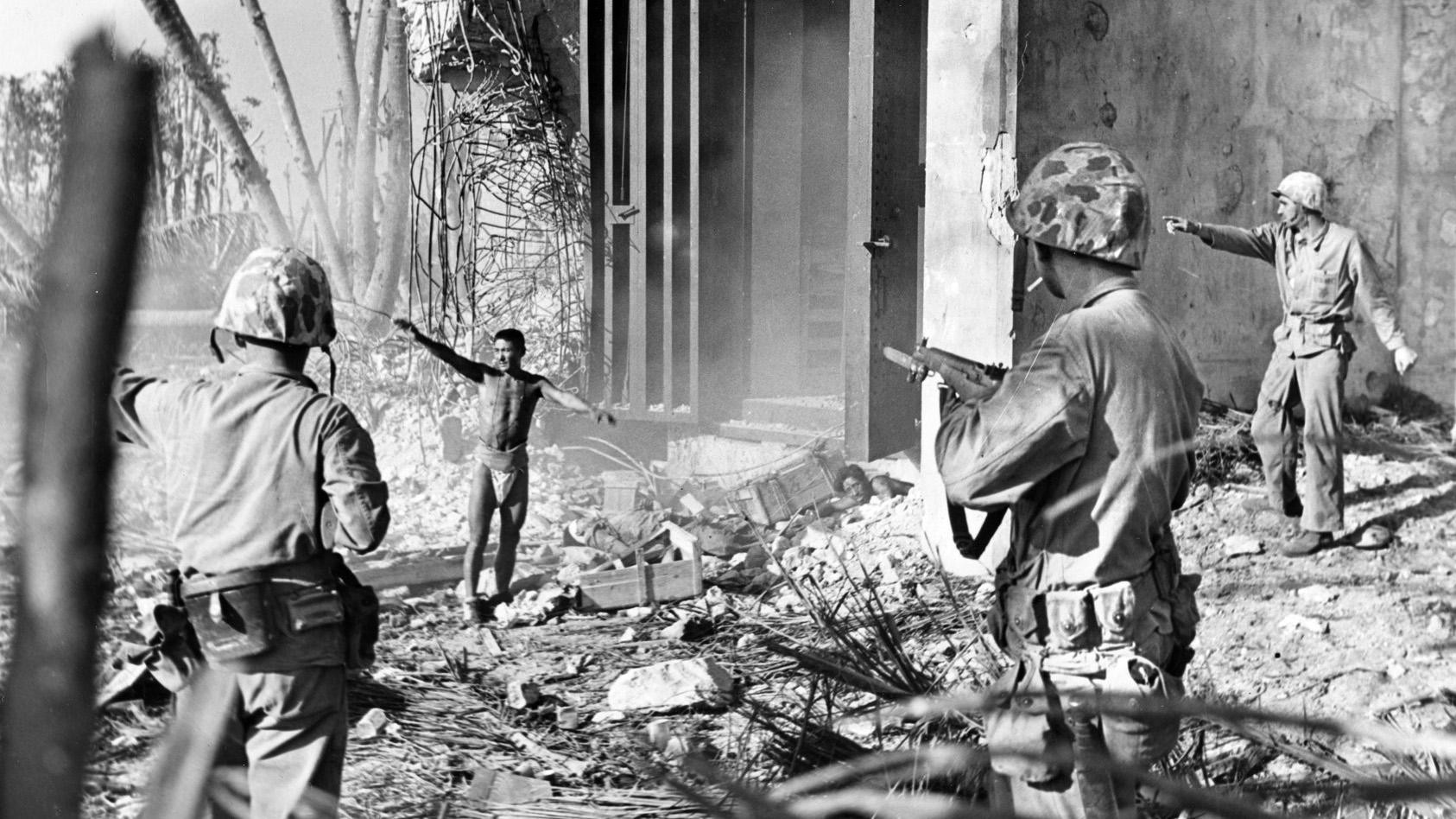
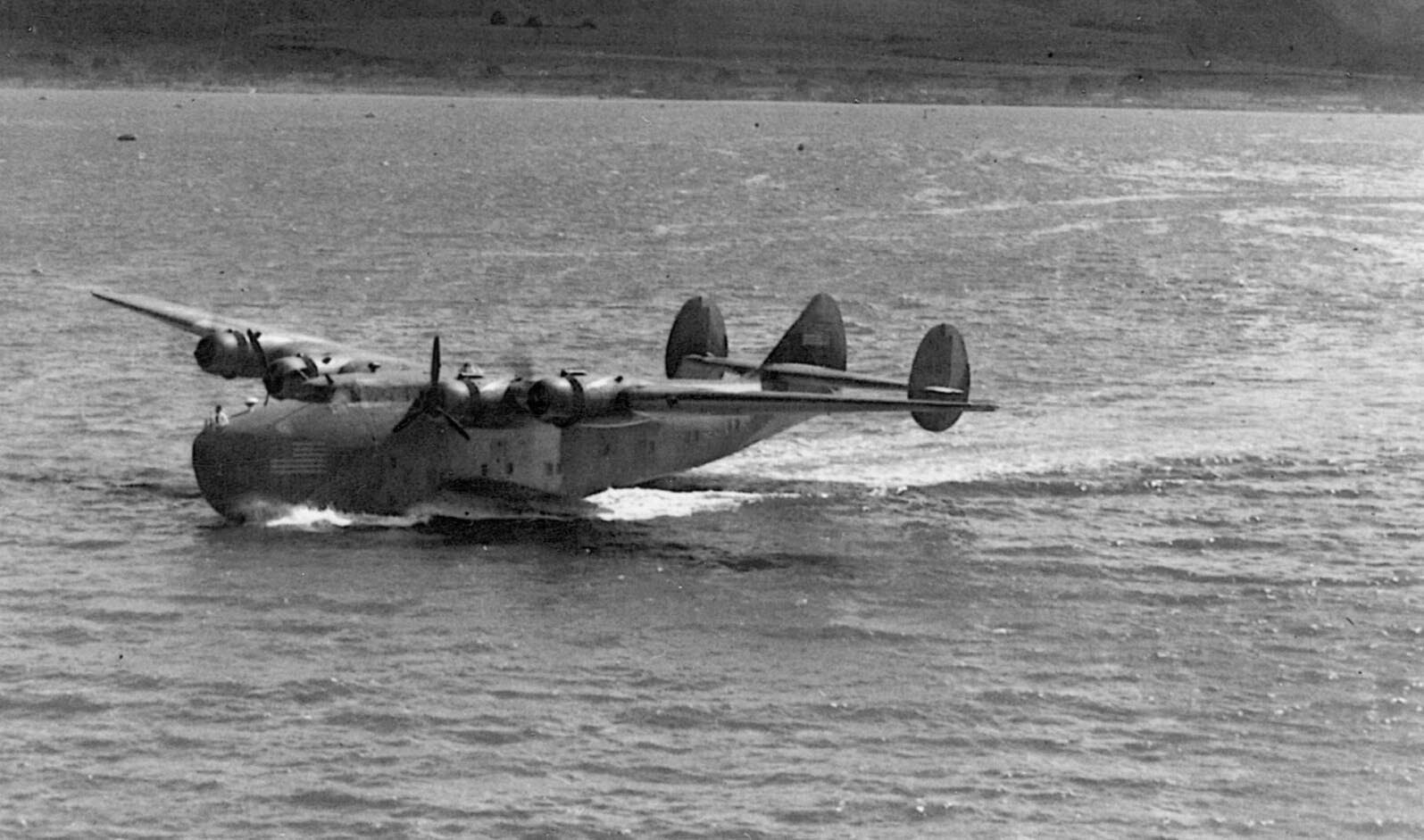

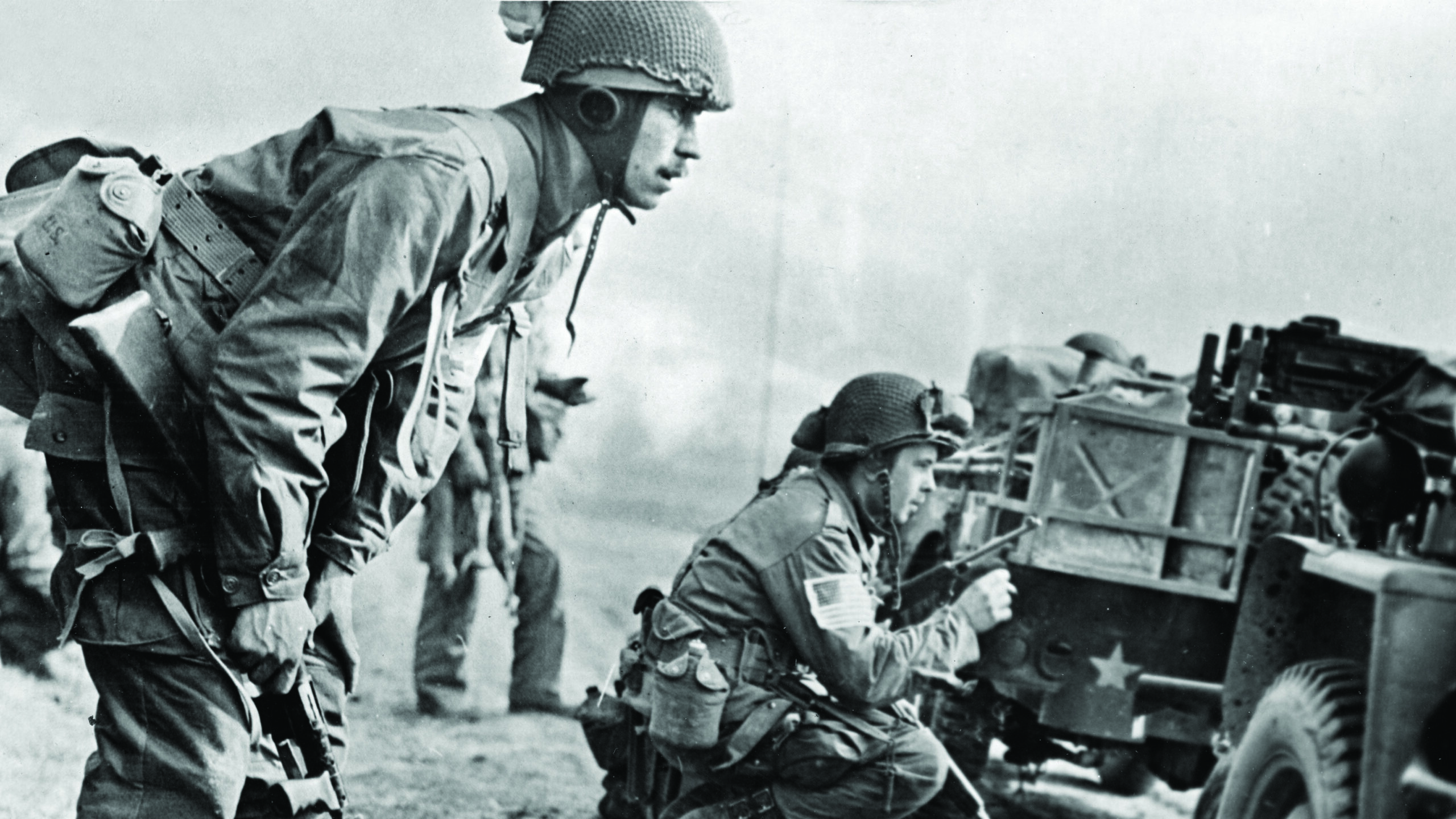
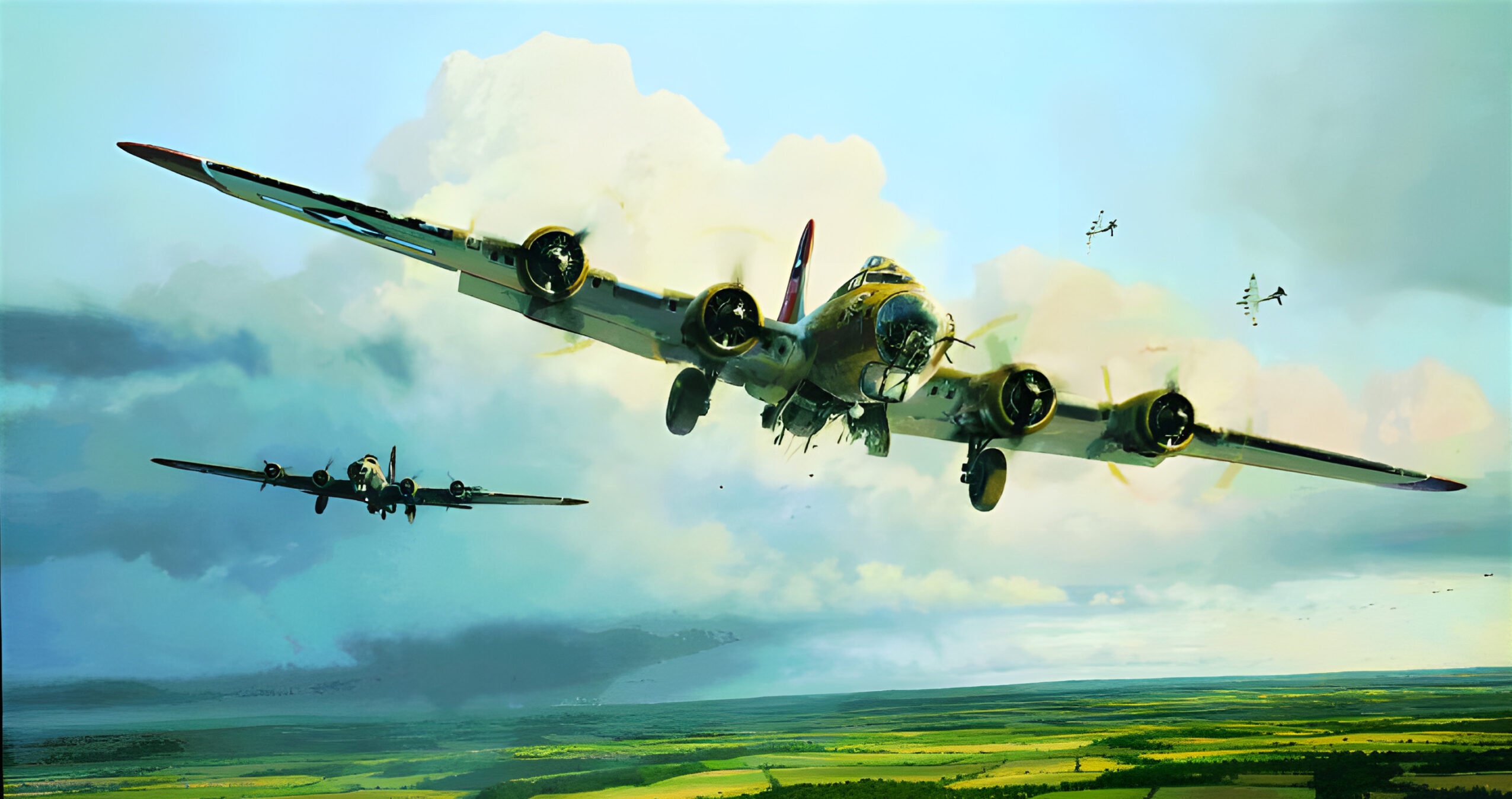
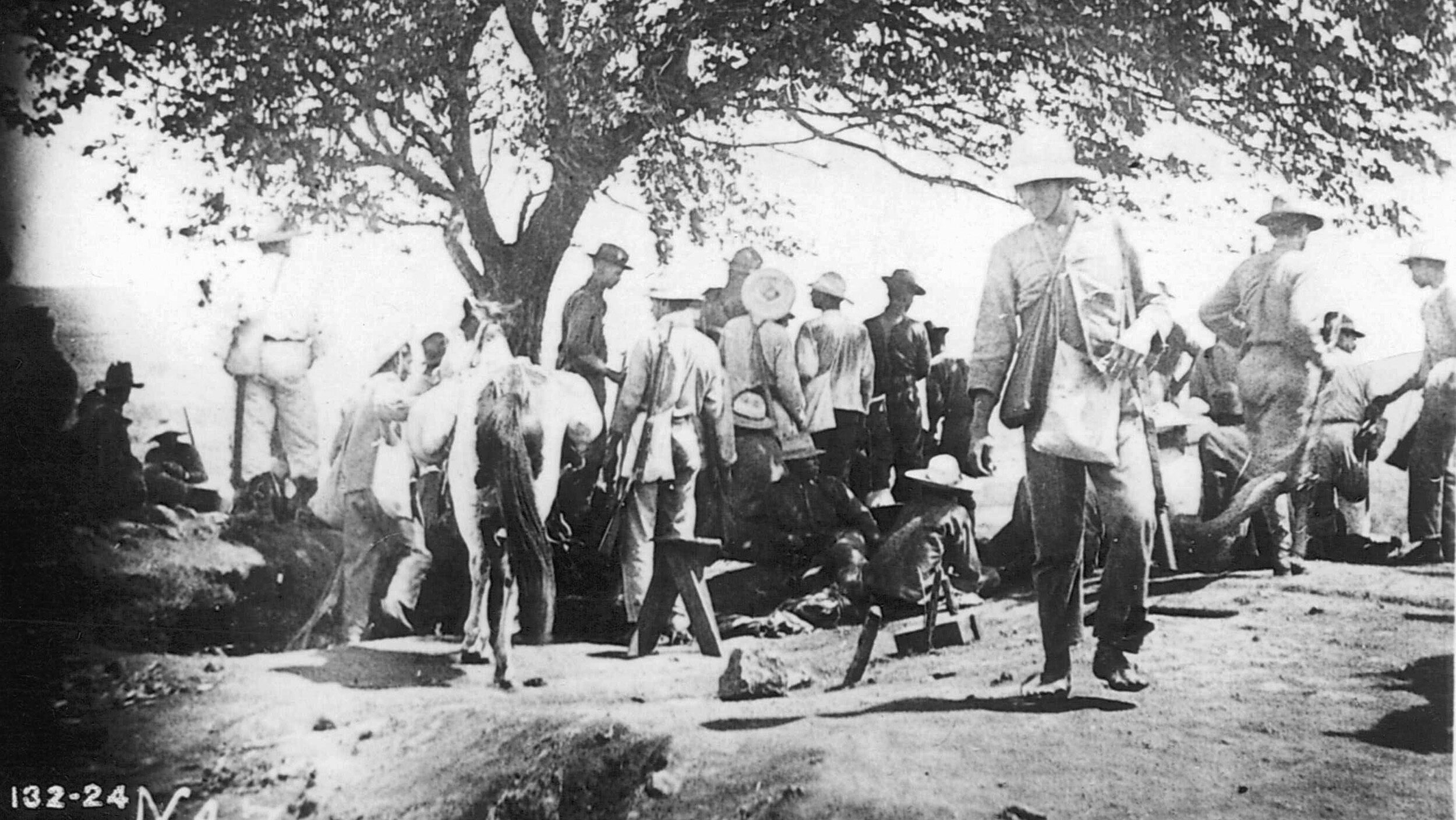
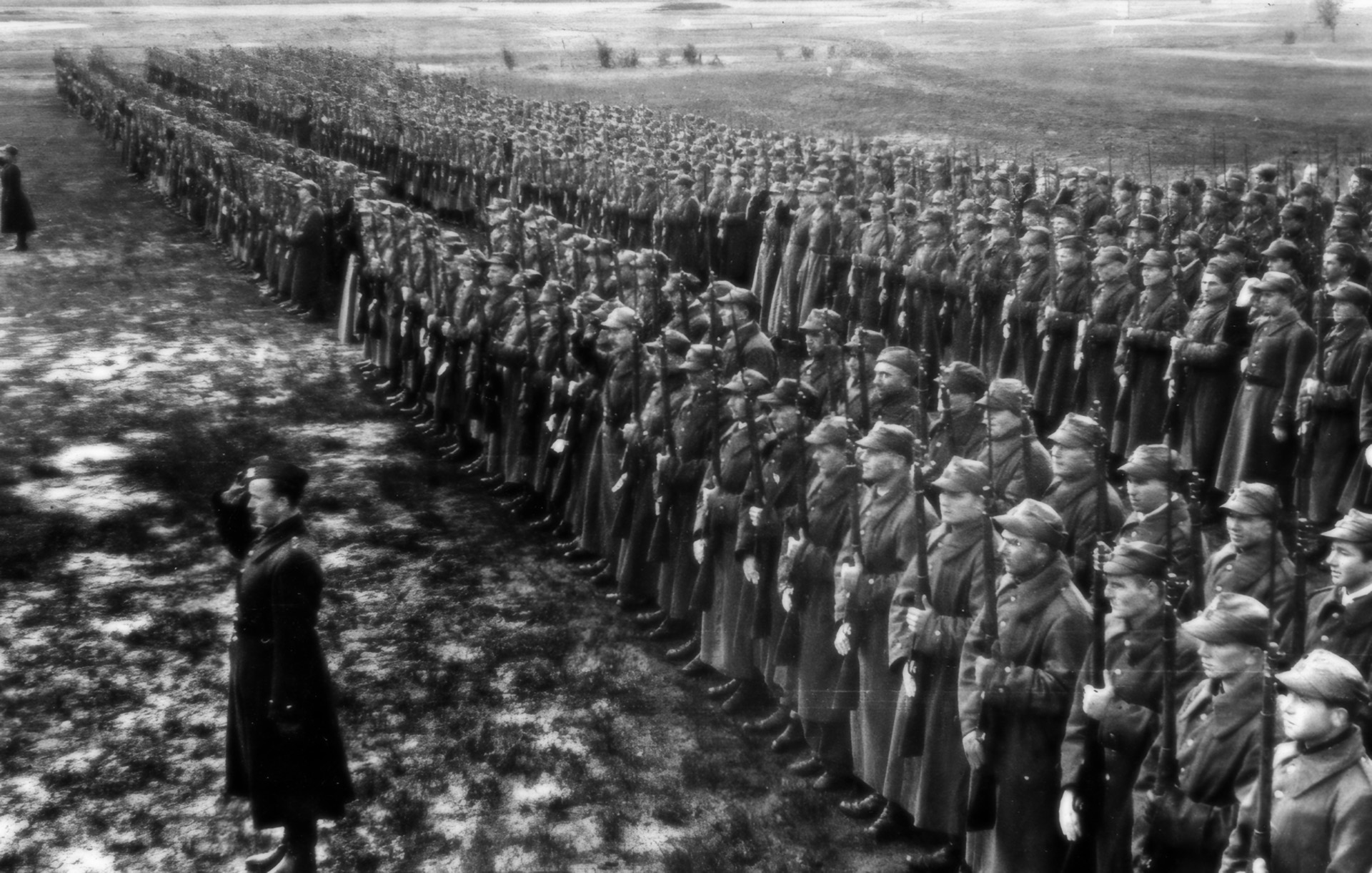
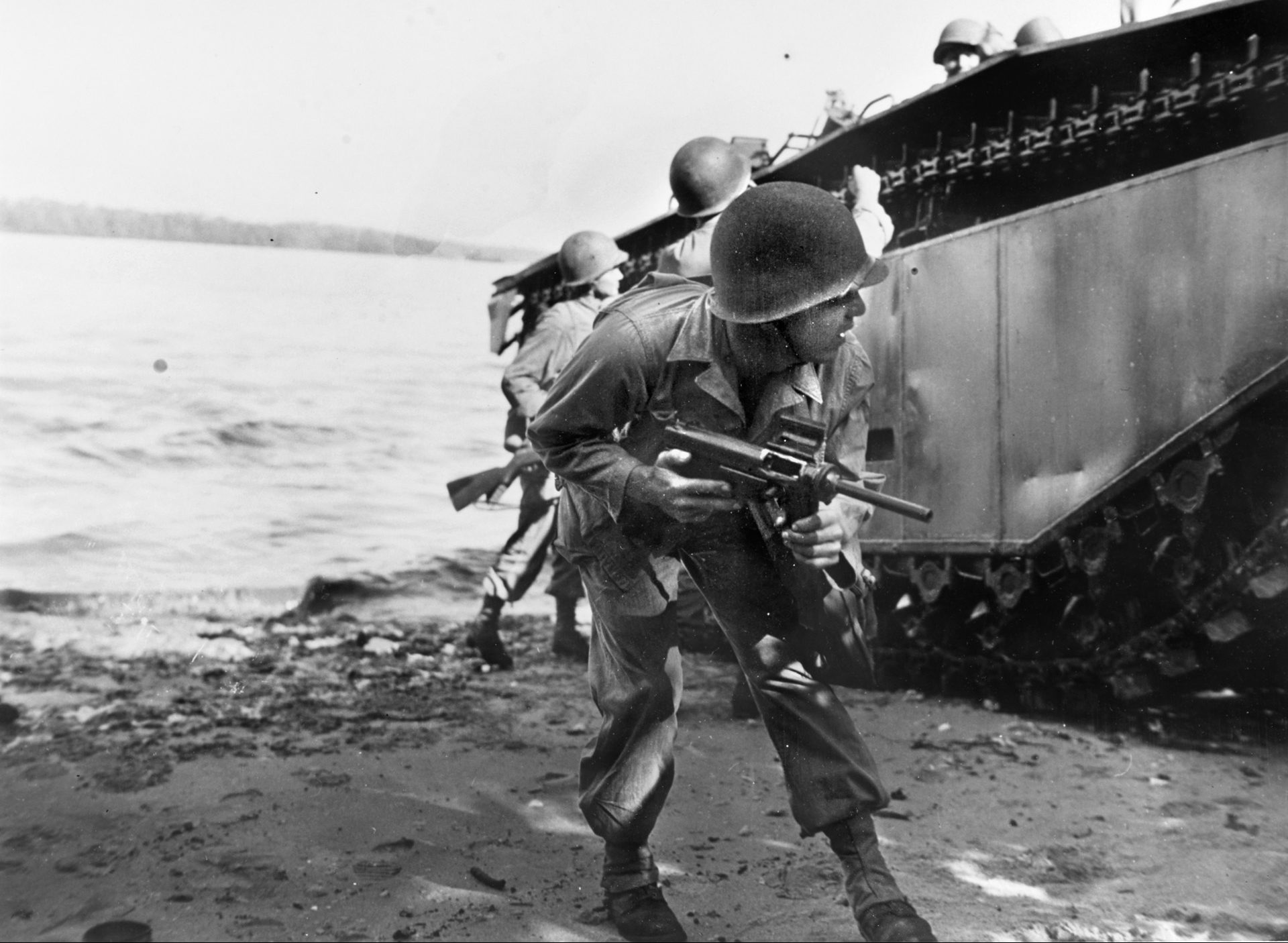
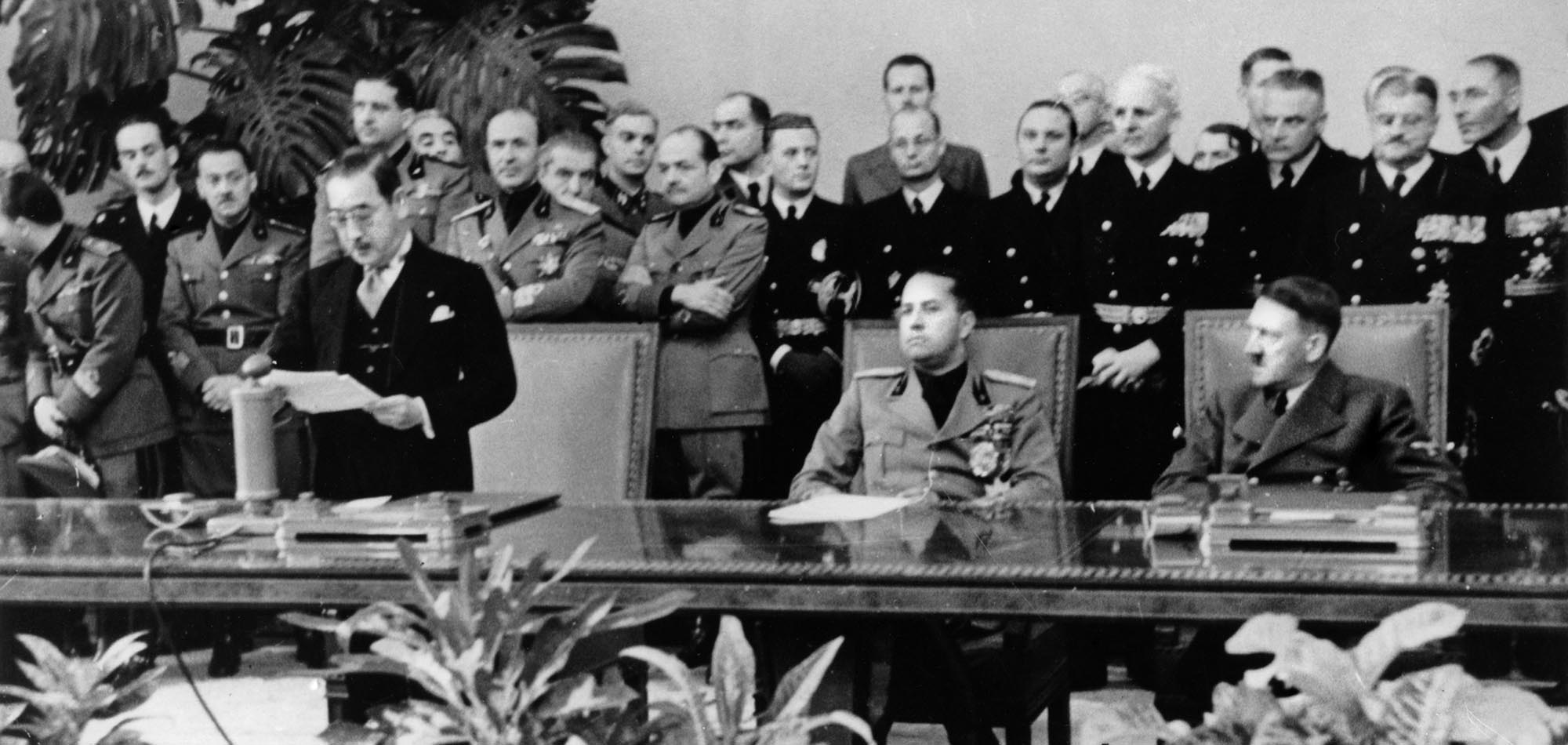
Join The Conversation
Comments
View All Comments